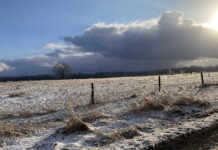I remember my mother’s first slow cooker, not a stoneware variety, but a rectangular Dutch-oven-type pot set on a base that not only kept the pot cooking, but doubled as a griddle-type electric skillet. Mom was teaching in those days. How welcome it was for all of us to come home to the smell of a supper almost ready. Things haven’t changed in that respect from some 40 years ago. We should use our crock-pots more often.
Slow cookers are a wonderful way to make a meal. The key to creating a delicious slow-cooked meal is knowing the rules. Follow these tips, and you’ll be creating warm, hearty recipes all year long:
— Temperatures must reach at least 165 degrees Fahrenheit for safe slow cooking. (The low heat on most models is about 200 degrees F.)
— To keep foods out of the food danger zone, always use fully thawed meats. Don’t use whole chickens or roasts; cut the meat or poultry into chunks to ensure thorough cooking.
— For best results, a slow cooker should be between half and two thirds full.
— Resist temptation to open the lid during the cooking process — each peek you take will add an additional 15 to 20 minutes of cooking time. Also curb your urge to stir; it’s usually not necessary.
— Cooking on low heat takes about twice as long as cooking on high heat. A general rule of thumb is that “low heat” means about 200 degrees and “high heat” is about 300 degrees.
— The ceramic insert in a slow cooker can crack if exposed abrupt temperature shifts. Don’t put a hot ceramic insert directly on a cold counter; always put a dish towel down first. Likewise, don’t put a ceramic insert straight from the refrigerator into a preheated base.
— You can certainly just pile food into the slow cooker and turn it on, but some recipes come out a lot better with a little prep time. Browning meat — especially ground meat — and sauteing vegetables in a skillet before adding them to the slow cooker will greatly improve the flavor of your meal. If you dredge your meat in a little flour before browning, you will get a thicker sauce.
— For high altitude cooking, add an additional 30 minutes for each hour of time specified in the recipe. Legumes take about twice as long as they would at sea level.
— Fat retains heat better than water, so fattier foods, like meat, will cook faster than less fatty foods, like vegetables. For more even cooking, trim excess fat off of meats. If you’re cooking a dish with both meat and root vegetables, place the vegetables on the bottom and sides of the insert and put the meat on top.
— Dairy products, like sour cream, milk or yogurt, tend to break down in the slow cooker. To prevent this, add them during the last 15 minutes of cooking.
— If you’re adapting a favorite recipe to the slow cooker, there are a few things you should keep in mind:
— Liquid is not going to evaporate, so cut back on the liquids by about 20 percent.
— If you’re using herbs, select whole leaves and spices, and use half the normal amount.
— If you’re using ground herbs, add them in the last hour of cooking.













I had the recipe you printed for Chicken Marsala in the crock pot and have lost it. Could you please email me this recipe? Thank You
It’s easy to find past recipes online. You can search our Web site for past recipes: http://www.farmanddairy.com/recipes/